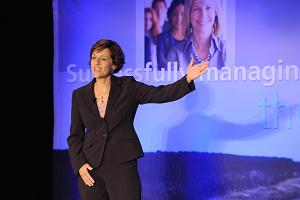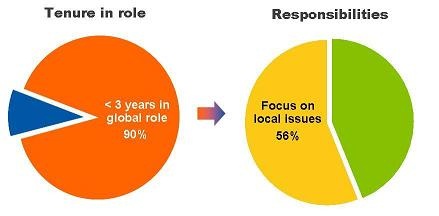Julia Velixon at Mercer recently presented a new study conducted with the Harvard Business School, based on interviews with senior HR leaders from 60 global corporation, focused on the challenges of HR leaders moving from local to global roles within an global HR function.
Key findings from the study:
 Workforces are becoming more globally-dispersed. The increased globalization of many of today’s businesses, both in terms of their penetration into new international markets, in addition to their adoption of global sourcing models across IT and corporate support functions, is significantly increasing the need for global HR practices. More than 50% of respondents’ workforces reside outside of their corporate home country – the pressure to standardize policies and processes, manage increased workforce mobility and manage compliance needs is greater than ever.
Workforces are becoming more globally-dispersed. The increased globalization of many of today’s businesses, both in terms of their penetration into new international markets, in addition to their adoption of global sourcing models across IT and corporate support functions, is significantly increasing the need for global HR practices. More than 50% of respondents’ workforces reside outside of their corporate home country – the pressure to standardize policies and processes, manage increased workforce mobility and manage compliance needs is greater than ever.
Many senior HR executives are stepping up into global roles, but are failing to divest of their localized issues. 45% of the executives have moved into global roles over the last two-to-three years, many of these transitioned in the last year alone. However, while roles are being structured globally, most of the executives have been struggling to get away from dealing with local and regional issues. For those working in global roles today, 9 out of 10 have less than 3 years experience and a failing to move away from their previous localized job roles:

HR… stepping up into global roles?
Lack of standardization. The lack of a consistent approach to governance and compliance, especially in Europe and Asia – where employment and tax laws vary widely in different jurisdictions – creates further challenges for HR leaders. There is also a lack of standardization around the approach to global mobility, which hinder’s HR’s ability to apply consistent procedures to the compensation and benefits of a workforce that has been growing rapidly. It is becoming increasingly important for companies to properly manage the logistics of moving there employees from country to country.
Download mercer_hbs_white_paper_september_2008.pdf
Posted in : Business Process Outsourcing (BPO), HR Outsourcing, HR Strategy







Phil,
You cite that, “most of the (HR) executives have been struggling to get away from dealing with local and regional issues.” In my experience, HR executives are struggling to get away from dealing with any issues whatsoever. When was the last time you called anyone in HR and they actually picked up the phone? The point is that HR’s diversity and harassment initiatives in the US have shifted their focus from being helpful and creative to being babysitting Nazis that show you videos of what you’re not to do and have you sign paperwork to cover their butts from lawsuits. These functions are irrelevant in any other country besides the over the top “polictcally correct” freaks in the USA. No wonder HR executives are vexed and helpless when they go abroad.
Schuyler Kennedy
Hi Phil,
I have identified the following challenges of moving to a global HR model:
1) Willingness to build a culture based in collaboration applied to a global business context: In today´s multicultural business contexts, where dispersed teams around the world must work cohesively by sharing an inspiring vision and based in the perspective that workplace environments tends to encourage practices of collaboration and active knowledge sharing, there is no better style of leadership to encourage and nurture cooperative work in multidisciplinary teams dispersed around the world than Servant Leadership. In facing such a perpective, corporate Human Resources should be a faithful guardian of the values, principles, beliefs and policies that are inherent to a strong culture of collaboration in global companies. For this reason, the Head of the corporate HR function should be an influential leader with influence worldwide, an exemplary role model to encourage good managerial practices and of course, has a seat at the corporate table.
2) Business Innovation as a competitive advantage: The imperative of being competitive in a global and complex business environment is motivating to world-class companies and to their leaders to introduce innovation in their processes as a value inherent to their cultures in order to gain the needed business differentiation to consolidate a sustained competitive advantage in a business environment where product’s lifecycles are shorter and customer base dictate the direction that the markets should follow in a more volatile and uncertain business landscape.
Current leaders should acquire a clear understanding about the requirement, rationale and convenience of introducing an innovative mindset as key element of the corporate culture and should have the willpower and influence to communicate credibly such initiatives to the employees in a clear, concise and convincing way.
3. Managing efficiently multicultural organizations: In global organizations that are engaged in developing transformational projects with a worldwide scope dealing with cultural differences in organizations requires from a strong, empowered and influential leadership with the willingness of applying the proper corporate governance practices to homogenize those differences around an inspiring business vision that being strongly encouraged by Senior Management and enabled by collaborative technologies may be instrumental in reducing the inefficiencies of having multidisciplinary teams geographically dispersed with different cultures working in markets, products and projects that could be intrinsic and inherent to the particular country´s culture, history and traditions.
Octavio
Forging leaner and higher capability HR functions and practices will not be easy in many organisations.
Firstly, it is clearly desirable that the key decision makers share an understanding of what they really want, and hence understand the realities of delivering real change in terms of resources and time – they will have a part to play. Secondly, there may be generational issues at work. For example, is the HR leader sufficiently forward looking and change oriented to lead transformation? Is he or she sufficiently dispassionate about people and processes to effect real transformation, while still recognising what is sensible to keep?
Another common challenge is the paucity of business-centred and transformation-oriented talent available to fill the more demanding posts of the leaner, meaner functions of the future. “HR leaders need both to inspire high achievers with rounded experience to join, while ensuring the skill and knowledge is sufficiently high, and longer-term career prospectslook rosy.
Another challenge is to strengthen the will and ability of line managers to become more effective people leaders, and to require less hand holding by HR executives, at what ever level, he adds. Achieving this shift starts with HR’s exertion of influence on leadership role models. “Of course, the context is potentially dizzying market and organisational change. HR needs to have the strength both to steer this and to effect more personal transformation – its own key executives need to be role models in their own right.”
The crucial challenge for HR is to understand that change is endemic to society – and that business must accept the need for continuous renewal. Understanding this enables HR to advance an organisation’s change agendas focused on the business context and how to create the type of organisation where people flourish. Here, organisational development gets the context right and develops a flexible organisation model while HR drives the people strategy.
“The irony is that success in organisational renewal often leads to ossification and preserving the status quo because of complacency. This is the biggest danger that even good HR functions face. In addition, all functions face the challenge of using technology and its HR applications.
Regards,
Rajnish Sinha
Hi Phil,
Having worked in a truly globally organised matrix organisation for the last 3 years in HR positions I must say that there are certainly benefits to the global way of working. A lot of thought leadership on various topics can be shared easily and structures and systems can be combined and implemented in a similar way in different countries.
I am from Europe, the Netherlands originally and have now worked for the last 5 years in New Zealand, Australia, Bangladesh and have travelled throughout several other countries in Asia and have seen that one size does not fit all but global consistency is very much possible in certain aspects.
As example we have just completed a merger where in about 18 months we did a harmonisation globally towards 1 salary structure, 1 global incentive plan and 1 HR database. (ca. 60,000 employees) Besides that we have rolled out employment policies and globally consistent people tools and processes for objective setting, performance evaluation, personal and competence development and salary planning. At the moment we are restructuring the HR organisation in order to support the transaction, global tools and administrative side of HR better and have the HR consultancy team dedicated to certain business units.
The challenges are always happening in the countries where the customer and employee reality is very different from the global perspective. One of the biggest benefits I have seen is that the flow of knowledge, transfers of people and therefore agility of the organisation increases tremendously with this structure. It does take a certain type of person to be able to work in this environment.
happy to discuss further.
kind regards,
Paul
Global mobility of executives is a good thing, organisations must do it for better exposure to the executives and also for the standarisation of in house practices. But, such standarisations can not go in a very streight way, because of local legal, cultural and behavioural limitations which need to be incorporated differently from place to place.
PH Singh